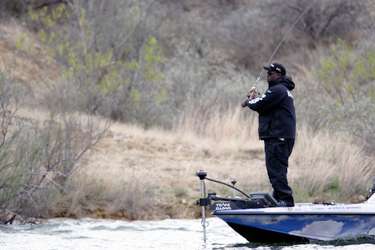
Finding fish is the name of the game, but to find what you’re looking for, you gotta know what you’re looking at. Fortunately for anglers, modern electronics have simplified and even amplified the elements of location and examination. Nowadays, fish that completely avoid detection are considered truly gifted. That’s because anglers are becoming increasingly skilled at leveraging new technological advancements to shift the big game of hide-and-seek in their favor.
One of the best at this routine is Bassmaster Elite Series pro Ish Monroe. Hailing from Hughson, Calif., Monroe rigs his Ranger boat with Lowrance sonar/GPS units — an HDS-8 at the console, HDS-10 on the bow. Both include Lowrance’s new StructureScan™, an add-on module that networks via high-speed Ethernet with up to three onboard Lowrance HDS units.
StructureScan combines the company’s SideScan and DownScan technologies along with conventional 2D sonar imaging for incredibly detailed views that provide invaluable insight into the subsurface scenario. Pairing this with a Navionics Platinum Chip provides the one-two punch that helps dial in the specifics needed to bag competitive stringers. Monroe offers three examples of his electronics strategies
: In a lake such as Table Rock, where anglers find standing timber and brushpiles, determining the difference is critical when the fish prefer one to the other. That’s where Monroe wants to place his Texas rigged Zoom Baby Brush Hog or Berkley finesse worm.
Where docks abound — lakes Norman and Murray, for example — bass could be anywhere. In reality though, only a fraction of the structures will be worth one’s time. Monroe prescreens a lake’s docks before committing any tournament time. “Structure scan helps me find docks that have some other type of cover,” he said, “like a chair or a tire.
I focus on docks that have something other than pilings, or floating docks that have something under them. “There are thousands of docks on lakes like Norman and Murray. If you fish as you normally do, you’ll waste a whole lot of time. In practice, I just ride around and look at docks, then mark the ones that have some type of additional structure. That’s the great thing about StructureScan — I’ve actually identified a chair and then caught a fish off that chair. Once he finds a dock with accessories, a Daiwa square-bill crankbait and a 3/8- or 1/4-ounce flipping jig are his baits of choice.
Perennial fish magnets, bridges represent a feast-or-famine scenario; the outcome of which depends upon an angler’s ability to determine where the fish are sitting. Drop shotting bridges with a Berkley finesse worm — Monroe’s favorite tactic — requires precise presentations.
“StructureScan allows me to see in between the pilings, and if there is a cross member, I can see under that cross member,” he said. “Bridge pilings can be anywhere from a foot to 100 feet deep, and on the deeper bridges there can be multiple cross members.
With the StructureScan, I can see if the fish are under the cross member, over the structure or off to the side.” Essential to each strategy is determining what lake factors make a particular area productive. For Monroe, the Navionics view provides a road map to the best neighborhoods. “The fish may be on brushpiles near creek channels, and the Navionics chip shows you where those creek channels are,” he said. “If you’re looking for deep points, it shows you that. Anyone can pull up to a main lake point because it’s obvious, but many times you’ll come down an even bank and it doesn’t look like it has a point, but there may be a small (submerged) point.
“The Navionics chip shows you everything you need to know about under the water. No one can tell you where the fish are, but that chip gives me a starting spot.”





